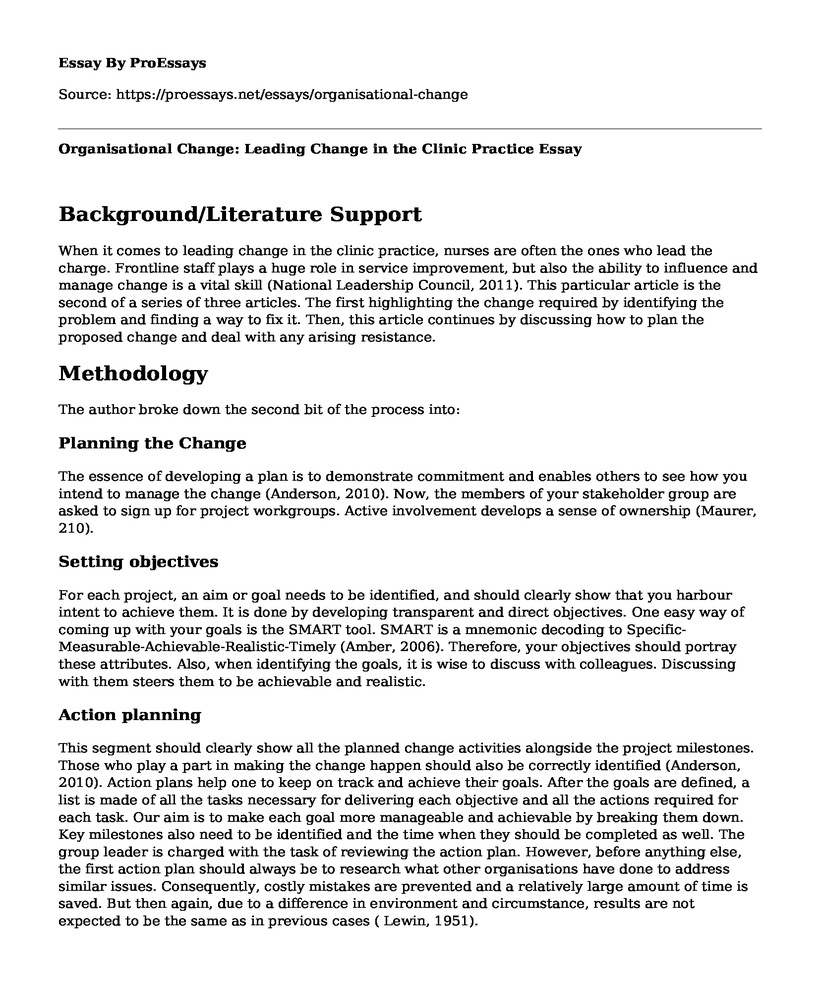Background/Literature Support
When it comes to leading change in the clinic practice, nurses are often the ones who lead the charge. Frontline staff plays a huge role in service improvement, but also the ability to influence and manage change is a vital skill (National Leadership Council, 2011). This particular article is the second of a series of three articles. The first highlighting the change required by identifying the problem and finding a way to fix it. Then, this article continues by discussing how to plan the proposed change and deal with any arising resistance.
Methodology
The author broke down the second bit of the process into:
Planning the Change
The essence of developing a plan is to demonstrate commitment and enables others to see how you intend to manage the change (Anderson, 2010). Now, the members of your stakeholder group are asked to sign up for project workgroups. Active involvement develops a sense of ownership (Maurer, 210).
Setting objectives
For each project, an aim or goal needs to be identified, and should clearly show that you harbour intent to achieve them. It is done by developing transparent and direct objectives. One easy way of coming up with your goals is the SMART tool. SMART is a mnemonic decoding to Specific-Measurable-Achievable-Realistic-Timely (Amber, 2006). Therefore, your objectives should portray these attributes. Also, when identifying the goals, it is wise to discuss with colleagues. Discussing with them steers them to be achievable and realistic.
Action planning
This segment should clearly show all the planned change activities alongside the project milestones. Those who play a part in making the change happen should also be correctly identified (Anderson, 2010). Action plans help one to keep on track and achieve their goals. After the goals are defined, a list is made of all the tasks necessary for delivering each objective and all the actions required for each task. Our aim is to make each goal more manageable and achievable by breaking them down. Key milestones also need to be identified and the time when they should be completed as well. The group leader is charged with the task of reviewing the action plan. However, before anything else, the first action plan should always be to research what other organisations have done to address similar issues. Consequently, costly mistakes are prevented and a relatively large amount of time is saved. But then again, due to a difference in environment and circumstance, results are not expected to be the same as in previous cases ( Lewin, 1951).
Understanding the Challenges
It would be simple if everyone was as committed to cause just as you are but this is not always the case. Therefore, as soon as the objectives have been clearly defined, there is the need to identify the forces acting in favour and opposition to the change so that one can come up with strategies to nullify them. The Lewins force field analysis becomes a useful tool here (Lewin, 1951).
Results
Dealing with Resistance
The tendency of human beings to offer resistance to change has been identified as one of the key factors hindering organisational change (NLS, 2011). In addition, the way one react to changes may well determine whether the project succeeds. Upon viewing resistance as a standard rational response to implementing change, you can reassure others that you are responding in an appropriate fashion to their concerns. Maurer (2010) identifies three types of levels of resistance. That is, People either understand you, or they do not; this kind of resistance comes about due to lack of information, lack of understanding of the information or disagreement with the information given. Secondly, people either are excited by or are afraid of change. Such response stems from fear and often occurs unconsciously or uncontrollably. Finally, it is either People have trust and confidence in a person or not. Occasionally, it has little to do with the immediate situation and could be deeply entrenched, stemming from relationships, culture, previous experiences or events.
Discussion and Conclusion
It is clear that changes have to occur in the management and the implementation processes of set objectives to improve the quality of clinical practices. At the forefront, nurses dependent upon as the core driving force and backbone of the modification. Implementing these changes is not easy, needs strategically planning, and powers of persuasion to be fully realised.
References
Ambler G (2006) Setting SMART Objectives. tinyurl.com/smart-ambler
Anderson A (2010) A Guide to Managing Change. tinyurl.com/SG-Change
Joanna K. (2012) Leading Change:2 planning.
LewinK (1951) Field Theory in Social Science. London: Harper Row.
Maurer R (2010) Beyond the Walls of Resistance.Austin, TX: Bard Press.
National Leadership Council (2011) NHS Leadership Framework. www.nhsleadership.org. uk/framework.asp
Cite this page
Organisational Change: Leading Change in the Clinic Practice. (2021, Mar 19). Retrieved from https://proessays.net/essays/organisational-change
If you are the original author of this essay and no longer wish to have it published on the ProEssays website, please click below to request its removal:
- Paper Example on People Management and Leadership
- Exploring Kohl and Hofstede Values Based on the Apple Company Essay
- Personal Statement on Supply Chain and Operational Management
- Paper Example on Strategic Planning in the External Environment
- Leadership Profile - Paper Example
- Essay Sample on Christian Leaders: Showing People the Path to Righteousness
- Research Paper on Organizational Strategic Planning: Change for Thriving & Outperforming Competitors







